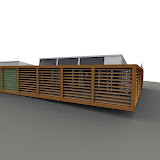 The concept for catchment house is to create a contemporary, urban homestead. It builds upon a vernacular of colonial verandas and bold rural timber structures with a clear hierarchy of living spaces.
The concept for catchment house is to create a contemporary, urban homestead. It builds upon a vernacular of colonial verandas and bold rural timber structures with a clear hierarchy of living spaces.The form sits above the gently sloping site; minimal impact is placed upon the ground with the design consisting of a single level platform upon point supports. The top layer of earth is only slightly cutaway to ease impact upon the existing ecology.
An internal plunge pool mediates between the floating pavilion and the geology of the site; it provides lateral restraint to the lighter structure, whilst acting as a stable cooling mass during the hot summer months.
An internal plunge pool mediates between the floating pavilion and the geology of the site; it provides lateral restraint to the lighter structure, whilst acting as a stable cooling mass during the hot summer months.
A strong modular frame is built upon the floor platform. It forms a predictable structural system allowing the best use of recycled timber, posts and beams reused from aged bridges, wharfs and woolsheds. The use of this regular structural arrangement sets a clear hierarchy within the internal spaces of the house. When a column has been removed, this creates a clearly exceptional circumstance within the space which lends itself to be a key living area
Variable pitch louvers provide a method to open or close down both the internal and external living spaces from the outer environment. Acid washed copper cladding is a modern interpretation of traditional corrugated metal cladding; this is layered horizontally in a standing seam profile.
Variable pitch louvers provide a method to open or close down both the internal and external living spaces from the outer environment. Acid washed copper cladding is a modern interpretation of traditional corrugated metal cladding; this is layered horizontally in a standing seam profile.
Thermal mass is utilised throughout the house in the form of hollow core precast concrete planks, these absorb heat from the winter sun and are insulated underneath to maximise their thermal potential. They also have a great cooling potential in summertime, where cooler air, from under the house, is drawn through their hollows to the inside. Internally the floor surfaces vary from polished concrete, carpet and sandstone tiles with the decks being more conventional grey ironbark strips.
Above the living platform and sturdy timber structure the roof form adds to the understanding of spatial hierarchy, with taller vaulted spaces being located above the more momentous living areas. These higher roof forms also allow deep solar penetration into almost all areas of the house from adjustable clearstory windows.
Whilst not outwardly exaggerating its eco credentials, it needs to be understood that the modularity of structure and the raised pavilion platform built into catchment house allows great potential to either install eco systems during construction, or retrofit (or even update) these systems at a later date. Systems akin to this type of residential build include: energy generation from photovoltaic cells or smaller scale wind turbines, grey water reuse and reticulation (toilet flushing), stormwater storage and use and even onsite black water retention, treatment and use in landscaping.
Above the living platform and sturdy timber structure the roof form adds to the understanding of spatial hierarchy, with taller vaulted spaces being located above the more momentous living areas. These higher roof forms also allow deep solar penetration into almost all areas of the house from adjustable clearstory windows.
Whilst not outwardly exaggerating its eco credentials, it needs to be understood that the modularity of structure and the raised pavilion platform built into catchment house allows great potential to either install eco systems during construction, or retrofit (or even update) these systems at a later date. Systems akin to this type of residential build include: energy generation from photovoltaic cells or smaller scale wind turbines, grey water reuse and reticulation (toilet flushing), stormwater storage and use and even onsite black water retention, treatment and use in landscaping.
The geometry of catchment house’s location on the site breaks away from a rigid alignment to the block boundaries. This helps develop the dialogue between the building and the context of the site, acknowledging the green field nature of this suburban development. It respects what has past whilst leaning towards a future “off the grid” urbane.
